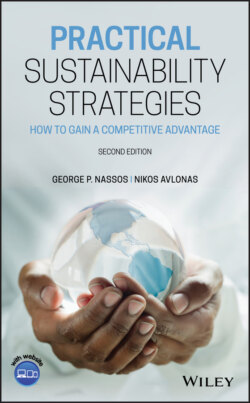Читать книгу Practical Sustainability Strategies - George P. Nassos - Страница 20
CLIMATE CHANGE
ОглавлениеIn 1988, the United Nations General Assembly created the Intergovernmental Panel on Climate Change (IPCC) with the task of reviewing and assessing the most recent scientific, technical, and socio-economic information produced worldwide relevant to the understanding of climate change. Further, it would provide the world with a clear scientific view on the then current state of climate change and its potential environmental and socio-economic consequences, notably the risk of climate change caused by human activity.
The first assessment report of the IPCC was presented in 1990 and along with subsequent reports led scientists to conclude that the earth cannot tolerate more than a 3–5 °F increase in temperature. In order not to exceed this level, the carbon dioxide emissions must be reduced 60–80% of the 1990 levels by the year 2050. The first in a series of international meetings took place in 1992 in Rio de Janeiro, Brazil, called the Rio Earth Summit. As a result of that meeting, five years later the Kyoto Protocol was adopted. It recognized that climate change was a result of greenhouse gases (GHGs) created by human industrial activity. The idea was that rich nations, which had already benefited from industrialization, would reduce their GHG emissions in the first part of the treaty and developing nations would join in later. Milestones were created in various intervals through the year 2050. One of the milestones was to reduce GHG 5% below 1990 levels by 2012. Instead, the world increased GHG by 58% above 1990 levels as the Kyoto Protocol came to an end.
At the next international meeting, which took place in Doha, Qatar, at the end of 2012, the developing countries once again demanded, as they did in Kyoto in 1997, for the rich countries to make a commitment to set real targets for reducing their GHG output. The rich nations then agreed to make some commitment toward a stronger legal agreement when they meet in Paris in 2015.
The primary goals of the Paris Agreement were to hold the increase in the global average temperature to less than 2 °C from pre-industrial levels, but also achieve net zero GHG emissions beginning in 2050. Each country made a pledge to reduce carbon emissions commensurate with its rate of emissions along with its technical ability For instance, the United States committed to reducing emissions 26–28% below 2005 levels by 2025. To achieve these goals, the public and private sectors must act boldly and quickly to reduce the use of fossil fuels and increase renewables as quickly as possible. In addition, if the technology can be developed, sequestering more carbon from the atmosphere would really enhance the goals of the agreement.
For the Paris Agreement to be successful, all of these countries, particularly the developed countries, must make the necessary investments in educating the masses, adopting renewable energy, reducing the use of fossil fuels, and developing carbon capture technology. But this will take a major financial commitment. For that reason, the next meeting of this Conference of Parties (COP22) took place in November 2016 in Marrakech, Morocco, to take action on the Paris Agreement including obtaining financial commitments from each of the countries and to establish plans for tracking progress by each country. This is all going in the right direction but none of these laws is binding.
Another measure of the carbon dioxide in our atmosphere is the actual average concentration in parts per million (ppm). Since the beginning of human civilization up until about 200 years ago, our atmosphere contained about 275 ppm [16] of carbon dioxide. A concentration of 275 ppm CO2 is a useful amount—without some CO2 and other GHGs that trap heat in our atmosphere, our planet would be too cold for humans to inhabit. In 2008, James Hansen, the top NASA climatologist indicated: “If humanity wishes to preserve a planet similar to that on which civilization developed and to which life on earth is adapted, paleoclimate evidence and ongoing climate change suggest that CO2 will need to be reduced from its current 385 ppm to at most 350 ppm [17].” This level of 350 ppm has been the target of many environmentalists and even Bill McKibben, who founded a worldwide organization to curb global warming, named his organization “https://350.org” [18]. Unfortunately, we are heading in the wrong direction as scientific instruments have shown that the earth's average carbon dioxide concentration reached 400 ppm in 2013 [19].
There are some scientists, while in the minority, who believe that global warming may exist and/or it is not anthropological. Regardless, reducing carbon dioxide emissions is like an insurance policy. If one assumes that global warming does exist and therefore takes the necessary action, the downside risk is minimal. If we learn in 20 years that global warming never really existed, it would have resulted in unnecessary development of renewable energy sources and possible introduction of a carbon tax. If on the other hand, one assumes that global warming does not exist and therefore takes no action at all, what would happen if this assumption is eventually determined to be incorrect. The result to the world population could be catastrophic with rising sea levels leading to flooding and droughts leading to dwindling food production.
